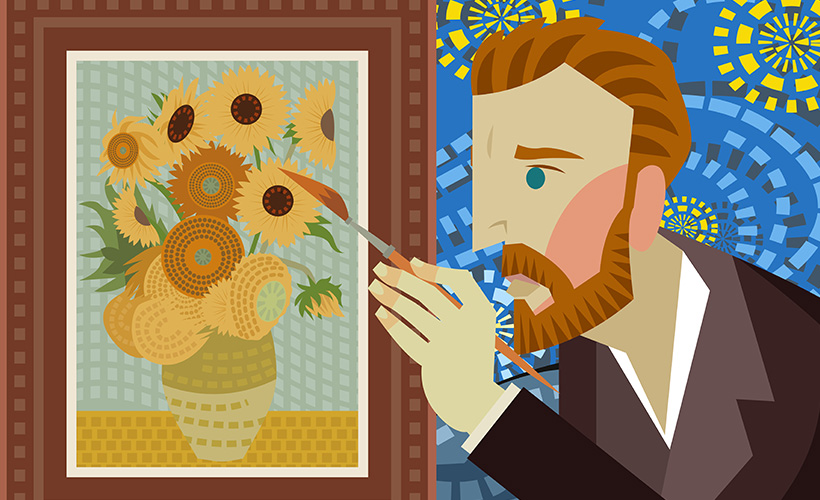I’ve always enjoyed impressionist art. I’m not overly knowledgeable when it comes to art, in fact, I had to use Google to confirm that this style of painting that I enjoy is actually called impressionism. I love trips to the Houston Museum of Fine Arts (MFAH), and I’ve collected a few original pieces that hang in my living room and office, purchased from an art gallery on a cruise I took right after I finished my undergrad degree. I couldn’t tell you much about many specific artists or styles. Art has always been one of those things that I get to enjoy without knowing everything about it. I enjoy it for what it is, without the burden of history or details.
One branch of impressionism that I particularly enjoy is apparently called pointillism (and yes, Google informed me of this, too). I discovered it on an MFAH trip a couple years ago. I think we were actually there to see a Van Gogh exhibit (Van Gogh is my favorite artist—unoriginal, I know, but what can I say?). That day, however, I found myself captivated by the way artists can create such beautiful art out of thousands of dots of paint.
You’re probably wondering why I’m ruminating on art on a blog about educational technology and instructional design. It does seem a little off-topic.
Exploration #40: Altered States
This week, I’ve chosen to complete Exploration #40 from Keri Smith’s How to Be an Explorer of the World. This exploration is titled Altered States and asks the reader to “Find a way to alter your physical experience of the world.” One of the examples was to squint your eyes, but as someone who’s worn glasses since fifth grade, I know that the fastest way to alter my perception of the world is to simply take off my glasses.

And so I stood at the edge of the concrete patio in my backyard, two dogs running circles through the grass, squirrels racing through the trees and across the fence, mariachi music blaring from a neighbor’s garage, and I took off my glasses.
There’s an oak tree growing just inside the back fence, and in the late afternoon, the sun shines through the branches and leaves. When I look at those branches without my glasses, the sunlight spilling through the tree turns into beautiful little dots of brightness, painting a pointillist picture that only I can see.
It made me wonder if some of those early pointillist artists were nearsighted. Maybe this was how they perceived the world, and in creating masterful works of art, they were simply describing how they viewed an oak tree.
If I had any artistic ability, or the time to try to discover any innate artistic talent, the sight of that blurry oak tree in my backyard would easily send me running to a canvas. But on the other hand, it’s kind of nice to know that I can find one of my favorite art styles created naturally in my own backyard. I just have to take off my glasses.

Reflection
This was a kind of stressful week for me. I’ve been feeling a bit overwhelmed and uncertain. When I flipped through the earmarked pages of my explorer book, I wasn’t sure that I was going to find an exploration that spoke to me or that would lead to meaningful lessons like the first two. I chose Altered States because it was easy to accomplish, and I could cross this task off of my to-do list.
And yet, this one feels a little bit more meaningful. It gave me a chance to take a break from my cozy yet dark office and spend an hour in the fading sun. As I write this blog, my background noise is birds and squirrels and dogs rather than the TV or music. I’ve found it all much more relaxing than I anticipated and definitely more meaningful.
But what did I learn from this exploration? Here are my lessons.
Lesson #1: Things that seem ordinary at first glance can appear completely different when out of focus.
Lesson #2: Nature is the best artist (second place is still Van Gogh).
Lesson #3: There are lessons to be learned even when you’re not really looking for them.
Lesson #4: Take your glasses off (real or metaphorical) and enjoy the art you see when you can’t see.

An important aspect of conducting any research is finding a topic that you find fascinating enough for extended study. I have always been curious about Vincent Van Gogh. Like many artists, he led such an interesting and sad life characterized by extensive mental illness.
Credo Reference contains a vast repository of information on the troubled painter (and I must add that seeing the term “pointilism” in the Van Gogh mind map was quite a thrill for me), including an article that states, “The inadequacy of medical records and the crudity of diagnosis in mental illness make it difficult to be certain, but it seems likely that Van Gogh suffered from a form of temporal lobe epilepsy whose symptoms often mirror the features of schizophrenia.” In my prior, admittedly brief, research, I hadn’t heard this possible explanation for his experiences. It makes me want to know more.
That is the true joy of research: taking something about which you know little but care much, and allowing curiosity to drive you to learn.
Learn more about Credo Reference for colleges and universities and public libraries, and take a FREE TRIAL today!
Originally published on Mrs. Hebert’s Classroom on February 13, 2022. You can also listen to the podcast here:
Like this article? Check out the previous blog articles in this series:
Also, check out the next blog articles in this series:
- Exploring the Farmers Market
- Exploring Beyond My Comfort Zone
- The Sounds of Exploration
- Exploring the Past (Without Time Travel)
- Exploring a World of Magic
See also:


